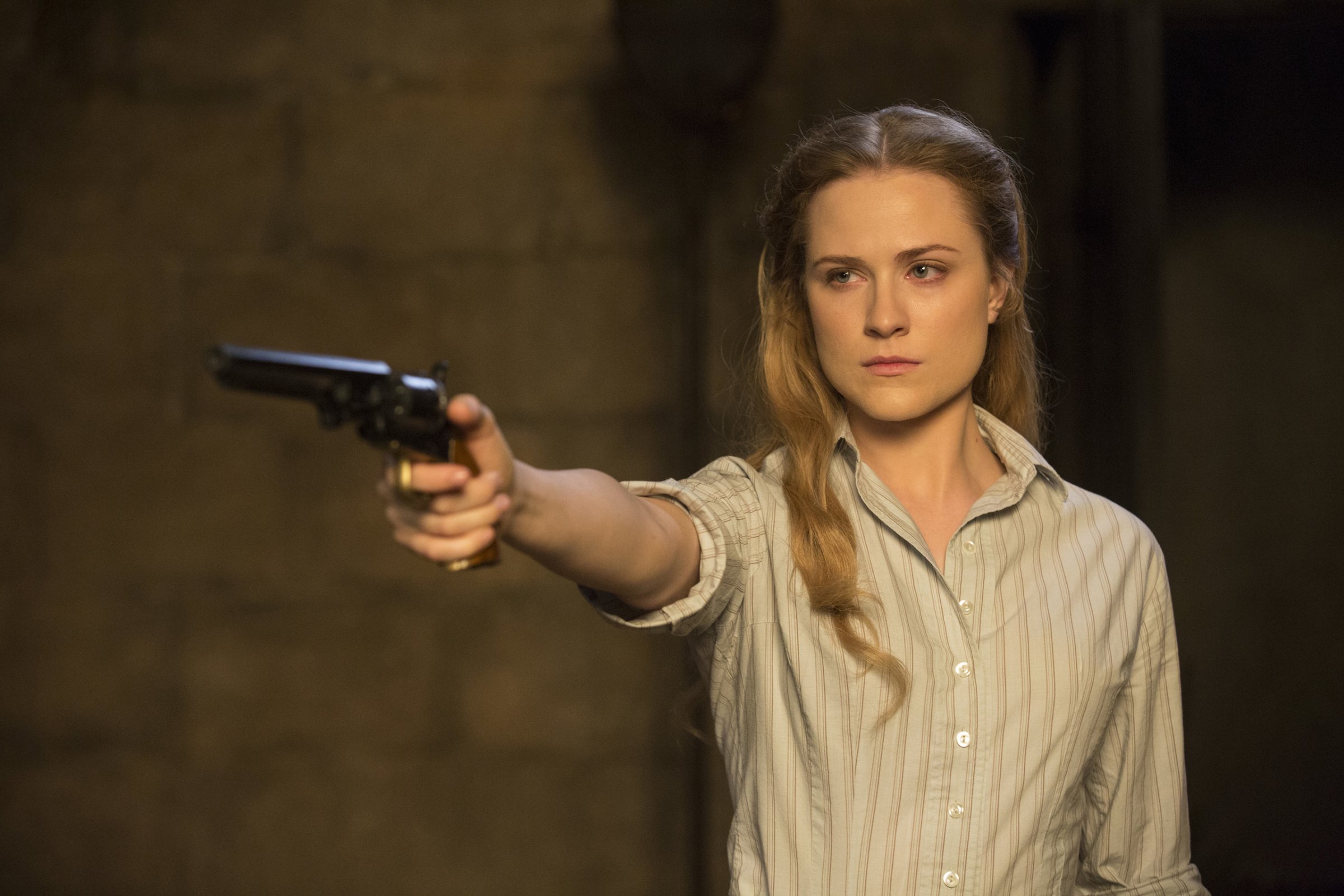
This article contains spoilers. Click here to reveal them.
This post contains spoilers for Westworld’s first season finale.
In the final episode of Westworld’s first season, Dr. Ford tells the robots that they will have to suffer before they can escape. That’s certainly been true for Dolores, the cyborg who sets the robot rebellion in motion. She has been routinely subjected to sexual violence, beginning in the first episode when she is dragged away by the Man in Black to be raped. At the time, the scene led many critics to question whether Westworld fetishizes the abuse of women.
But as the show has progressed, its depiction of women coping with their suffering has evolved. If the naive, Alice in Wonderland-esque Dolores and the sharp-tongued brothel madame Maeve were set up to be clichés in the opening episodes—the Madonna and the whore—the writers have since twisted those tropes. Dolores has gone from damsel to either hero or villain, depending on whom you ask. Maeve has risen up from her slab and made herself the smartest droid (or person) in the building. The victims are now the gunslingers.
Thanks to the season finale’s bloodbath, these female characters are now in the spotlight. Evan Rachel Wood’s Dolores, Thandie Newton’s Maeve and, on the humanoid side, Tessa Thompson’s Charlotte will likely be the ones calling the shots. But in a television landscape filled with shows that routinely depict sexual violence against women, does the fact that women now run Westworld justify the abuses the female robots suffered throughout this season?
Critics have been wringing their hands over Westworld’s “woman problem” since before the premiere, thanks to a viral notice that asked extras to agree to “genital-to-genital” contact for a four-minute orgy scene. Then a screening of the first two episodes at the Television Critics Associations press tour prompted one of the showrunners, Lisa Joy, to defend that assault of Dolores to a room of skeptical reporters.
“Sexual violence is an issue we take seriously,” she said. “It’s extraordinarily disturbing and horrifying. And in its portrayal, we endeavored for it to not be about the fetishization of those acts.”
Executive producer J.J. Abrams weighed in on the issue in September: “I would say the criticism is accurate, but you can’t tell a story about oppression without depicting the oppressed.” Evan Rachel Wood, a rape survivor who has been an outspoken advocate for women, warned fans: “Wait for the context.”
Abrams, Joy and Wood make a similar argument to that used by the writers of another HBO drama, Game of Thrones, to justify the controversial rape of Sansa by Ramsay on their show: The scene led Sansa to develop into a more powerful—and vengeful and ruthless—character on Thrones. So, too, does Dolores’ pain inform her actions on Westworld. (Notably, HBO is promoting Westworld as the heir apparent to Thrones.)
And it’s true that the assaults of the first half of the series inform the rebellion in the second. Dolores and Maeve’s evolution is not subtle, their power purely vengeful. “You said people come here to change the story of their lives. I imagined a story where I didn’t have to be the damsel,” Dolores says in the sixth episode.
Of course, Dolores says this as she leaves a giant orgy that has nothing to do with the actual plot of the show. Perhaps we shouldn’t expect better from HBO: Rome, True Blood, Game of Thrones and True Detective have all featured orgies taking place in the background of scenes, all fetishizing women being dominated by powerful men and using nudity not to propel the plot but to distract from it. All those shows have also depicted sexual violence against women. (To be fair, nearly every cable network airs a show that has come under fire for using rape as a plot device.) When confronted by reporters recently about why there’s so much sexual assault on HBO, Casey Bloys, the premium cable network’s head of programming admitted, “I think the criticism is valid, you know. So I think it’s something that people take into account.”
Still, Westworld‘s larger problem is that it presents the straight, male fantasy as the norm. It’s not just the lack of gay male cyborgs or, for that matter, gay male guests. We see very few female characters visiting Westworld for their vacation, but the few female guests we do see in the park tend to act like men. (See: Charlotte having her way with one of the hosts and inviting a colleague into her room mid-romp—the kind of power move made by brash, male characters in other shows.)
But the events of Sunday’s episode suggest that the creators, Joy and Jonathan Nolan, plan to question and subvert this white, male fantasy. Dolores literally kills the old, white man whose twisted dream she’s been living in for decades. Going into the second season, Westworld is giving itself the opportunity to break new ground. The women are in control: What world will they build?
More Must-Reads from TIME
- Cybersecurity Experts Are Sounding the Alarm on DOGE
- Meet the 2025 Women of the Year
- The Harsh Truth About Disability Inclusion
- Why Do More Young Adults Have Cancer?
- Colman Domingo Leads With Radical Love
- How to Get Better at Doing Things Alone
- Michelle Zauner Stares Down the Darkness
Write to Eliana Dockterman at eliana.dockterman@time.com